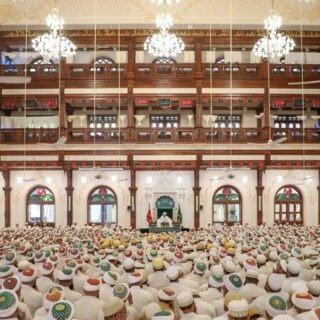The risalat on music is followed by a risalat which contains discussions on the right combinations. In it the Imam emphasizes three types of progressions: quantitative (kammiyah), qualitative (kayfiyah) and the third an amalgamation of the quantitative and qualitative.
The quantitative is known as the Arithmetic progression, the qualitative is the Geometric Progression and the third is known as the Harmonic Progression.
Arithmetic progression
Arithmetic progressions are those having equal differences between numbers, ie 1,2,3,4,5 are differentiated by 1; 2,4,6,8 are differentiated by 2 as are 1,3,5,7 etc. These numbers and their type have a distinct feature in that the sum of the halves of any 2 successive numbers results in a number exactly halfway between the two. Eg 3 and 4: half of 3 is 1.5 and half of 4 is 2; 1.5+2 = 3.5 which is halfway between 3 and 4.
Geometric progression
This involves the ratio between one number and another within a sequence. For example 4, 6 and 9 wherein 4 is to 6 what 6 is to 9 (4:6=6:9). 4=2/3×6, 6=2/3×9. Similarly in reverse 9:6=6:4; 9=6+1/2×6 and 6=4=1/2×4.
Similarly 8,12,18,27 wherein 8=2/3×12, 12=2/3×18, 18=2/3×27 and also in reverse; 27=18+1/2×18, 18=12+1/2×12.
Geometrical progressions are of 2 sub-types; separated and non-separated. The example given above is of a non-separated (continuous) type. In such a sequence in any given successive 3 numbers the first of those numbers multiplied by the third is equal to the square of the middle number eg 4,6,9 where 4×9=6×6. If there are 4 numbers then the product of the 1st and 4th is equal to that of the 2nd and 3rd eg 8,12,18,27; 8×27=12×18.
A separated sequence is 4,6,8,12 wherein the ratio of 4:6 = 8:12 but not 6:8. A feature of these sequences is also that the product of the 1st and 4th numbers is equal to that of the 2nd and 3rd.
Harmonic Progressions
In the sequence 1,2,3,4,6; 6 is the upper degree, 3 is the lower degree and 4 is the middle degree. 1 and 2 are the differentiators, ie, the difference between 6 and 4 is 2 and that between 4 and 3 is 1.
The ratio of the upper degree (6) to the lower degree (3) is the same as that between the differentiators ie 2:1=6:3.
These also apply in reverse; 3:6 = 1:2
Similarly 1:2 = 2:4 = 3:6 and in reverse too.
From another angle 6:4 = 3:2 and vice versa.
It is from this series that musical harmonies are derived.
A knowledge of harmonic combinations is important as Allah has created every thing from a mix of more than one element as a sign of his oneness. Therefore, every combination that is harmonious is effective and acceptable as is evident from the pleasing effects one enjoys in calligraphy, painting, medicine, cooking and other similar skills. The beauty of the structure of the human body also lies in the correct proportions of its organs. Thus, men of wisdom (Hokama) gave preference to this knowledge as no craft, skill or task could be done properly without it.








